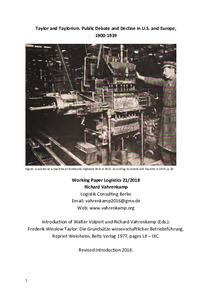Taylor and Taylorism
| dc.date.accessioned | 2023-04-28T11:32:29Z | |
| dc.date.available | 2023-04-28T11:32:29Z | |
| dc.date.issued | 2023-04-20 | |
| dc.identifier | doi:10.17170/kobra-202304247882 | |
| dc.identifier.uri | http://hdl.handle.net/123456789/14638 | |
| dc.language.iso | eng | |
| dc.rights | Attribution-NonCommercial-NoDerivatives 4.0 International | * |
| dc.rights.uri | http://creativecommons.org/licenses/by-nc-nd/4.0/ | * |
| dc.subject | steel works | eng |
| dc.subject | effectiveness movement | eng |
| dc.subject | Braverman | eng |
| dc.subject | Dahrendorf | eng |
| dc.subject | Gass | eng |
| dc.subject | Philadelphia | eng |
| dc.subject | Pennsylvania | eng |
| dc.subject | Herbert Simon | eng |
| dc.subject | Copley | eng |
| dc.subject | Kanigel | eng |
| dc.subject | Krupp | eng |
| dc.subject | Midvale | eng |
| dc.subject | Carnegie | eng |
| dc.subject | steel industry | eng |
| dc.subject | steel mill | eng |
| dc.subject | quantification | eng |
| dc.subject | Breger | eng |
| dc.subject | conservation movement | eng |
| dc.subject | American society of mechanical engineers | eng |
| dc.subject | scientific management | eng |
| dc.subject | motion study | eng |
| dc.subject | film camera | eng |
| dc.subject | Henry Ford | eng |
| dc.subject | Bethlehem Steel | eng |
| dc.subject | high speed steel | eng |
| dc.subject | Tabor Manufacturing | eng |
| dc.subject | Highland Park | eng |
| dc.subject | Gantt | eng |
| dc.subject | Emerson | eng |
| dc.subject | Gilbreth | eng |
| dc.subject | Hoxie | eng |
| dc.subject | Dodge | eng |
| dc.subject | Link Belt | eng |
| dc.subject | punch card | eng |
| dc.subject.ddc | 300 | |
| dc.title | Taylor and Taylorism | eng |
| dc.type | Working paper | |
| dcterms.abstract | Beyond the perspectives of labour science and industrial sociology, in which extensive deepening of the division of labour can be crystallized as an element of consensus under Taylorism, the concept of Taylorism found its way into general intellectual history. In 1954, the German-American management expert Drucker ranked scientific management among the most important contributions of the USA to Western culture. The dissemination of the concept of Taylorism in Western culture outlined here points to a high rank of Taylor's persons in the history of science and industry. The 3rd chapter reflects the economic and ideological conditions for the emergence of Taylorism at the turn of the century 1900 in the USA in the industrial environment of Philadelphia and Pennsylvania with its steel works and machine shops. It mentions two of the developments in economic history of USA: the monopolisation and the emergence of the new assembly-oriented industries. The industrial milieu of Philadelphia, where Taylor was to gain his first industrial experience, greatly favoured the development of his later ideas as is shown. It also seems appropriate to look back and to reflect on Taylor's actual achievements and place them in the general history of industry. This is the subject of the 4th chapter. Here Taylor's efforts to put his ideas into practice and their acceptance by industry and the public are critically presented. Taylor must be taken at his word and the somewhat beautifully coloured picture that he draws of his personal efficiency and the success of his management system in his publication “The Principles of Scientific Management” must be corrected by confrontation with the traditional history of early Taylor. This procedure, as a by-product, throws away some material on the history of technocratic movements that has so far remained largely unknown. | eng |
| dcterms.accessRights | open access | |
| dcterms.creator | Vahrenkamp, Richard | |
| dcterms.extent | 51 Seiten | |
| dc.contributor.corporatename | Kassel, Universität Kassel, Fachbereich Wirtschaftswissenschaften | ger |
| dc.subject.swd | Philadelphia, Pa. | ger |
| dc.subject.swd | Dodge | ger |
| dc.subject.swd | Taylorismus | ger |
| dc.subject.swd | Eisen- und Stahlindustrie | ger |
| dc.title.subtitle | Public Debate and Decline in U.S. and Europe, 1900-1939 | eng |
| dc.type.version | publishedVersion | |
| dcterms.source.series | Working Papers Logistics | eng |
| dcterms.source.volume | No. 21/2018 | |
| kup.iskup | false |
Dateien zu dieser Ressource
Das Dokument erscheint in:
-
Publikationen [14]



